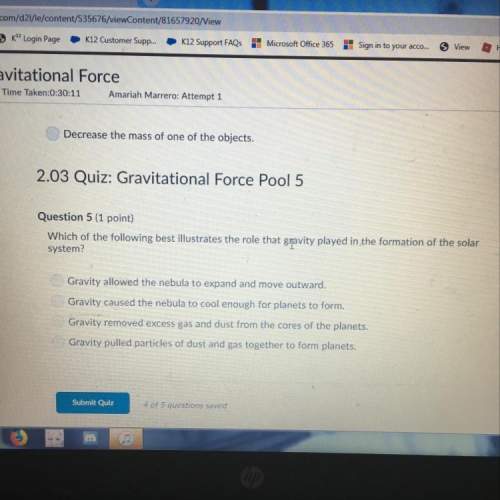
Chemistry, 15.04.2021 20:30 donaji1024perez
Activity
In this activity we'll use a simulation to observe how the mass on a spring affects its resting equilibrium point and also ha
oscillation.
Question 1
To begin your investigation, open this simulation: Masses and Springs e
Part A
First, let's Investigate the relationship between extension and force. In this case, the force is supplied by a mass under the
• Set the friction slider to "lots," to help damp out spring oscillations and make it easier to judge resting positions.
Using spring 1 and the ruler, observe the equilibrium position with no mass attached. Measure to the bottom horiz
spring. Record in the data table below.
Carefully add each mass in turn: 50 grams, 100 grams, and 250 grams and recording the spring's resting position in
measure to the bottom horizontal section of the spring.
Finally, for each of these masses, record the extension x: the displacement between the equilibrium point without a
equilibrium point with the mass attached. (You'll have to do a subtraction.)

Answers: 3


Another question on Chemistry

Chemistry, 22.06.2019 05:50
Astudent made a graph plotting the progress of a reaction over time. the student forgot to label the y-axis of the graph. a graph is shown with two graph lines. one graph line starts at a higher position on the y axis and slopes downwards towards the right. the other graph line starts at a lower position on the y axis and slopes upwards towards the right. the two graph lines stop short of intersecting each other and continue as separate lines which gradually become straight and parallel to the x axis. a vertical line is shown at a point where the two graph lines finally became parallel to the x axis. this vertical line is labeled equilibrium. the title on the x axis is time and an arrow pointing towards the right is shown above time. the title on the y axis is left blank. what best explains the label that the student should use on the y-axis? amount, because as the amount of product decreases, the amount of reactant increases over time. reaction rate, because forward and backward reaction become equal at equilibrium. amount, because the amounts of reactants and products become constant after equilibrium is reached. reaction rate, as the rate of forward reaction increases and rate of backward reaction decreases over time.
Answers: 3

Chemistry, 22.06.2019 10:10
When electrolyzing copper (ll) chloride, what reaction takes place at the anode? what reaction takes place at the cathode?
Answers: 1

Chemistry, 22.06.2019 17:50
Cryolite, na3alf6(s), an ore used in the production of aluminum, can be synthesized using aluminum oxide. start this question by first balance the chemical equation.1.) balance the equation: - alo3(s)+naoh(l)+hf(> na3alf6+h2o(g). 2.) if 17.5 kilograms of al2o3(s), 51.4 kilograms of naoh(l), and 51.4 kilograms of hf(g) react completely, how many kilograms of cryolite will be produced? 3.)which reactants will be in excess, (al2o3, naoh, or hf) 4.)what is the total mass of the excess reactants left over after the reaction is complete in kg?
Answers: 2

Chemistry, 23.06.2019 05:00
Which characteristics affect ocean water’s temperature? check all that apply. depth location mass salinity waves
Answers: 1
You know the right answer?
Activity
In this activity we'll use a simulation to observe how the mass on a spring affects its re...
Questions

Mathematics, 02.04.2020 16:11

Engineering, 02.04.2020 16:12





Mathematics, 02.04.2020 16:12


Geography, 02.04.2020 16:13


Chemistry, 02.04.2020 16:13


English, 02.04.2020 16:14

Social Studies, 02.04.2020 16:14

History, 02.04.2020 16:14




English, 02.04.2020 16:16




